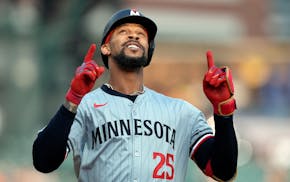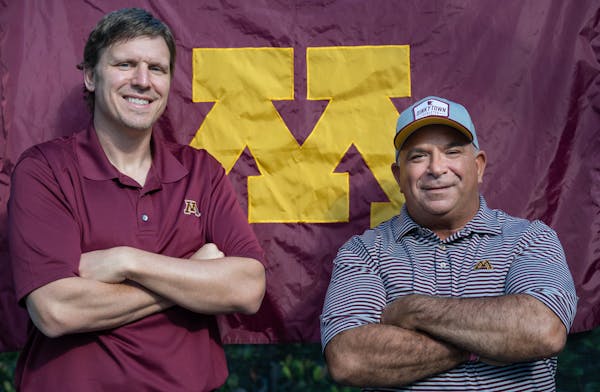The NIL revolution: An occasional Star Tribune series starts today examining how the name, image and likeness era is transforming college sports.
. . .
You don't need a law degree to decipher what has upended college sports, just this guide with answers to 10 questions about the NIL era.
First, what exactly is NIL?
Name, image, likeness (NIL) is a catch-all phrase that came in the wake of a unanimous 2021 Supreme Court decision in National Collegiate Athletic Association v. Alston, which ruled that the NCAA had violated antitrust laws by "restricting the education-related benefits that student athletes may receive." In practice, that ruling meant that student athletes could now seek financial compensation related to athletic performance. Simply put, "NIL" means college athletes can be paid by an external party (a business or a donor, typically) for being college athletes. That had previously been restricted by the NCAA; benefits used to legally go only from schools to athletes (athletic scholarships, lodging, athletic apparel and meals).
How do NIL collectives operate?
NIL collectives serve as conduits between athletes, those wanting to contribute money and athletic departments. Collectives consult with schools on priorities for NIL funds and match athletes with endorsement opportunities. Dinkytown Athletes, for example, consults with Jeremiah Carter, the University of Minnesota's senior associate athletic director for NIL who oversees the University of Minnesota's NIL/policy and risk management. Athletes are not required to use collectives, and some have brokered NIL deals on their own. However, collectives offer efficiency with the ability to facilitate larger-scale opportunities that could cover a group of athletes, such as a business sponsoring an entire team for an NIL function.
What do athletes do to earn NIL money? And do they have to pay taxes?
An athlete deal usually requires them to perform a service in order to get paid. For example, a local business may offer a certain amount of money to attend a meet-and-greet. On a larger scale, a company may ask the athlete to post an image of them using their product on one of their personal social media platforms. In exchange for a certain amount of live appearances or social media posts, the athlete will get compensated, usually directly to their bank account. What an athlete has to do to earn money from their NIL deal is negotiated in each individual contract. But once an athlete has earned money from their name, image and likeness they are considered self-employed and taxed accordingly. While colleges cannot directly pay athletes, they can help them get financial and legal advice related to NIL.
How are NIL earnings for each player tracked? Is it public or private data?
Student-athletes disclose any earnings they make to their respective athletic departments, which then collect and organize data for every team. Individual NIL earnings and reports for each team can be acquired through public data requests to the university, but athletes' names are kept confidential. NIL collectives track each players' earnings through contracts signed for each deal and donations, but that information is private. NIL platforms for athletes such as Opendorse, INFLCR, Altius, Athliance and others help secure national deals and provide estimated earnings. Recruiting site On3.com tracks NIL deals for athletes and ranks high school and college athletes by their projected earnings.
Are NIL rules uniform throughout the NCAA?
The NCAA has tried to implement uniform rules since launching its initial NIL policy in June 2021, but any authority the NCAA has appears to be on shaky ground. The attorneys general of Tennessee and Virginia sued the NCAA on its enforcement of NIL rules, and on Feb. 23, a federal judge granted a preliminary injunction against the NCAA, preventing it from enforcing NIL rules. Under the ruling issued by Judge Clifton Corker, which covers the entire country, the NCAA cannot restrict collectives from offering money for prospective student-athletes to attend an NCAA school. Without uniform rules, schools and collectives continue to try to navigate what is allowed and what is not on an individual basis.
Who can donate to NIL and what can be stipulated? Can I pick a specific team or player to support?
The only people who cannot currently donate to NIL opportunities are coaches and athletic administrators. Fans and boosters can donate through collectives or agencies and can get very specific in where they want their money targeted. Dinkytown Athletes co-founder Derek Burns said that individuals can request their funds be used for specific teams or student-athletes. This isn't far removed from how universities used to do athletic department fundraising efforts, for a new arena, locker room or increased travel budget. The only difference is NIL money goes to athletes, not the college.
Who are the various parties in an NIL deal, and what are their specific roles?
Let's follow the money, while noting seven different parties involved in an NIL deal. The money starts with parties that want to contribute money, either (1) a donor or (2) a business. At most universities, collectives (3) play a middle role in many deals. The student-athlete (4) is on the receiving end, and he or she may be represented by either an agent or agency (5). It's not uncommon for the athletes' families (6) to help navigate these deals. University officials (7) aren't directly involved in dealmaking, but they certainly play an at-large role in NIL by educating and assisting student-athletes, for example, or by partnering with one or more collectives.
Do universities make money off NIL deals?
The only way a university would make money on an NIL deal is if there is official licensing involved. Using an example at Minnesota: If a Gophers athlete is working with a business to produce a hoodie with their image on it and that hoodie also includes the school's "Block M" logo, the U would receive its normal licensing fee. And those agreements are typically handled by a third party negotiating with the business. Otherwise, no, universities don't take a cut or otherwise profit when one of their student-athletes signs an NIL deal.
Does Title IX apply to NIL?
This is one to watch in 2024. Title IX requires schools to provide equal opportunities and benefits to men and women athletes. And yet with NIL, schools aren't involved in the process of money changing hands, from donor or business to student-athlete: Collectives play that role. Schools do need to provide equal opportunity to men and women athletes to secure NIL deals, but since they don't play a role in dollar values or the NIL dealmaking processes they aren't required to balance NIL values equally for men and women. There's already one high-profile legal challenge, at the University of Oregon, regarding equal opportunity for NIL deals. Expect gender equity to be a prevalent topic in NIL discussion this year.
What are the current legal challenges to NIL and collectives?
There have been myriad legal challenges in the wake of the Supreme Court ruling. The recent judicial ruling out of Tennessee that the NCAA couldn't restrict collectives from paying players to attend their school is just the latest in a string of decisions that continue to side with athletes over the NCAA. Dartmouth basketball players were recently given recognition as school employees by the National Labor Relations Board, which gives them the right to unionize, and other cases are moving through the courts regarding whether athletes are university employees. Also, several cases have student-athletes suing the five major conferences for backpay over lost revenue, seeking damages in the billions. There have also been multiple congressional hearings seeking to answer if the government should exert legislative authority over NIL.
Star Tribune staff writers Marcus Fuller, Randy Johnson and Chip Scoggins, along with Star Tribune sports intern Gavin Dorsey, contributed to this report.
Ben Lively strikes out 6, Guardians top struggling Phillies 3-1 in key interleague showdown


